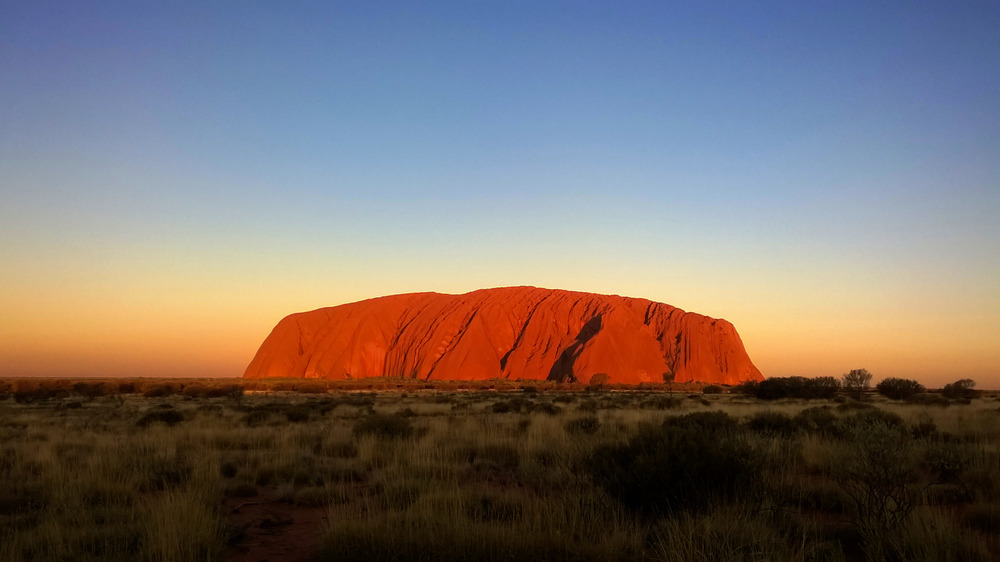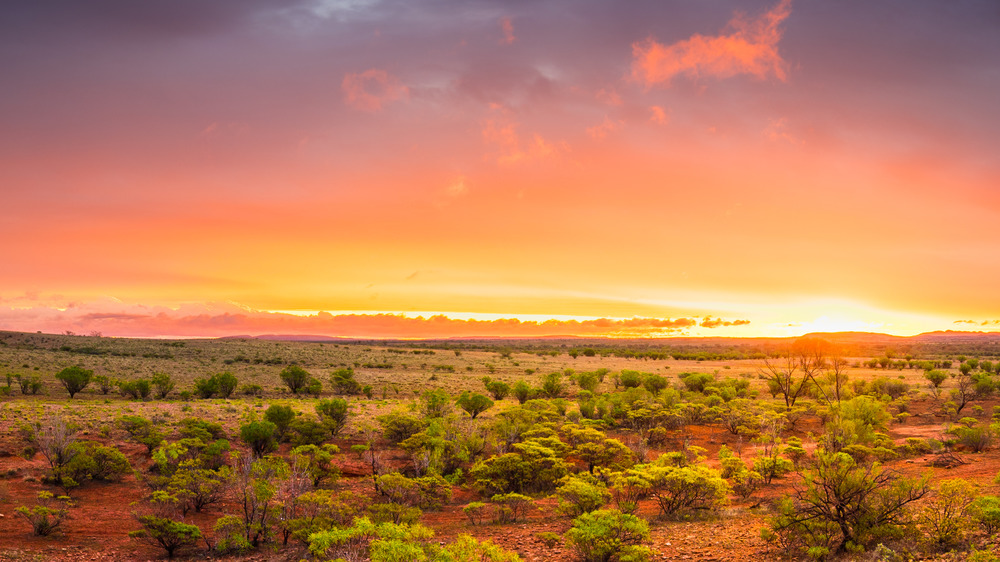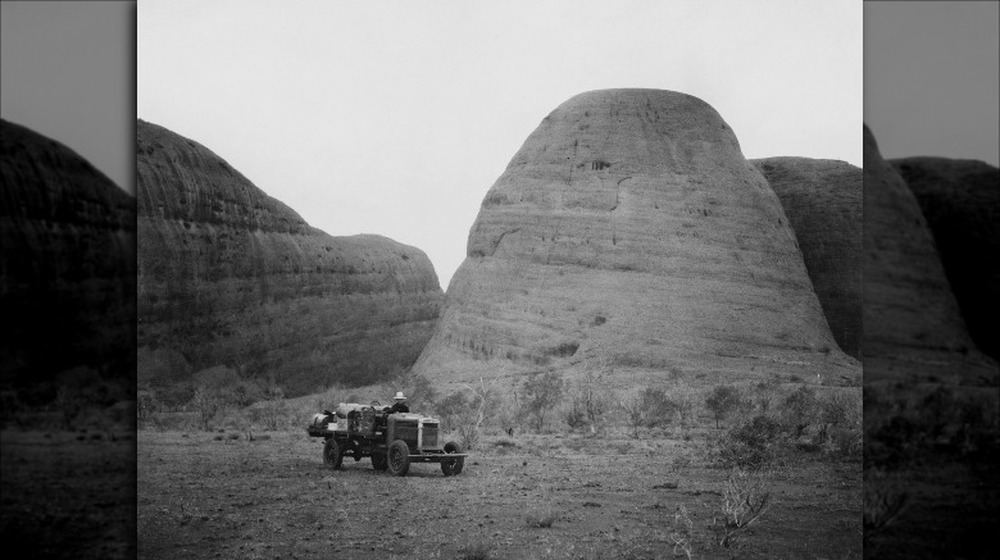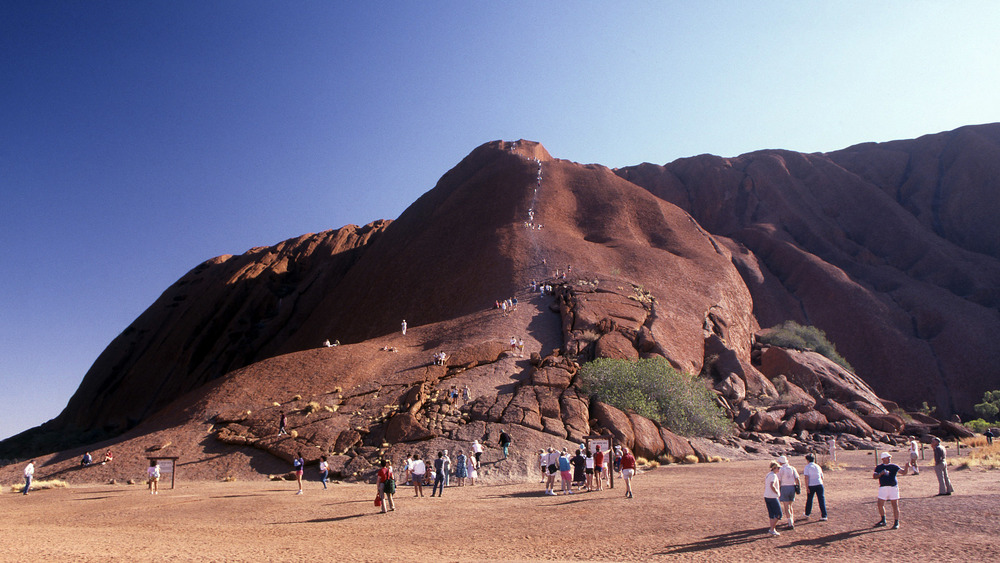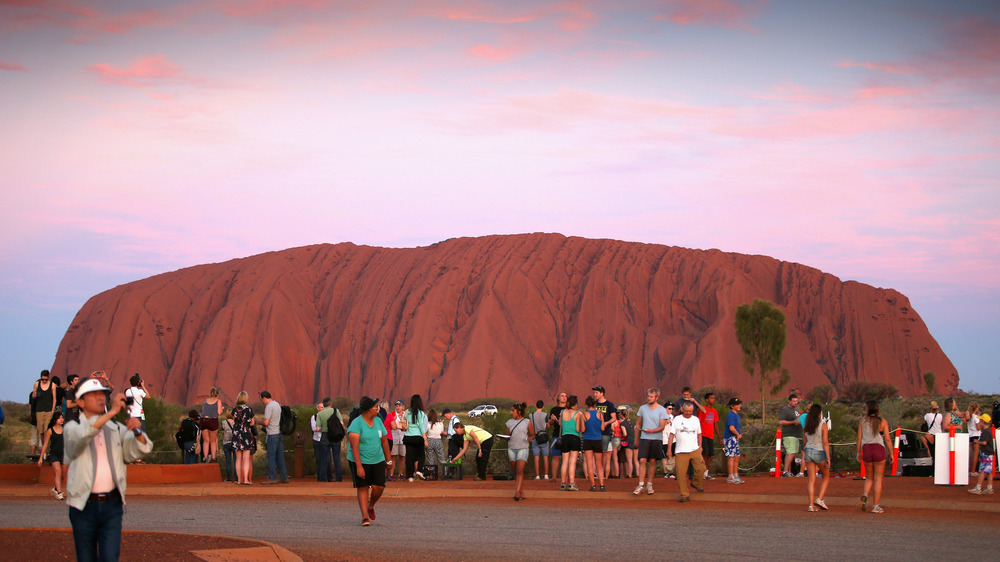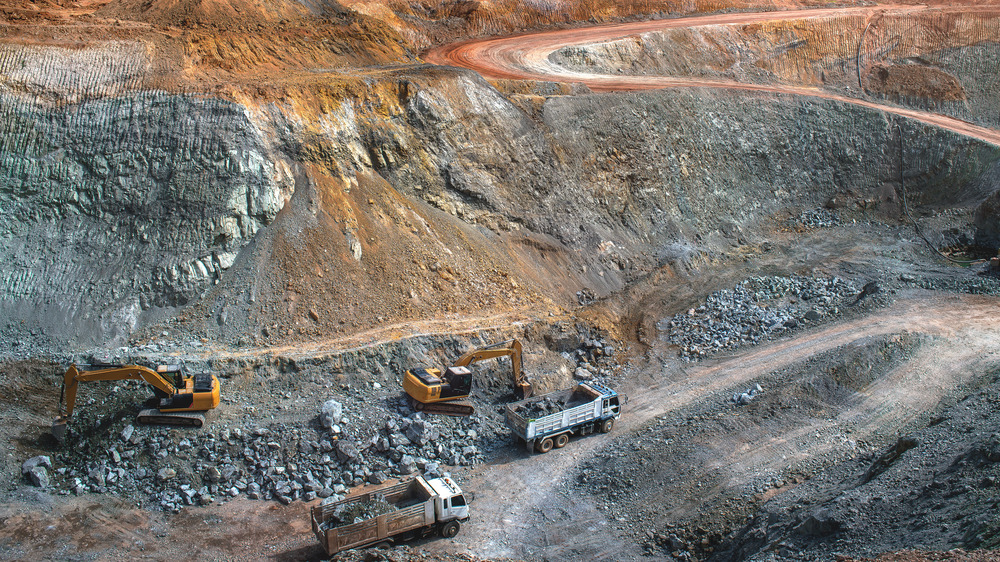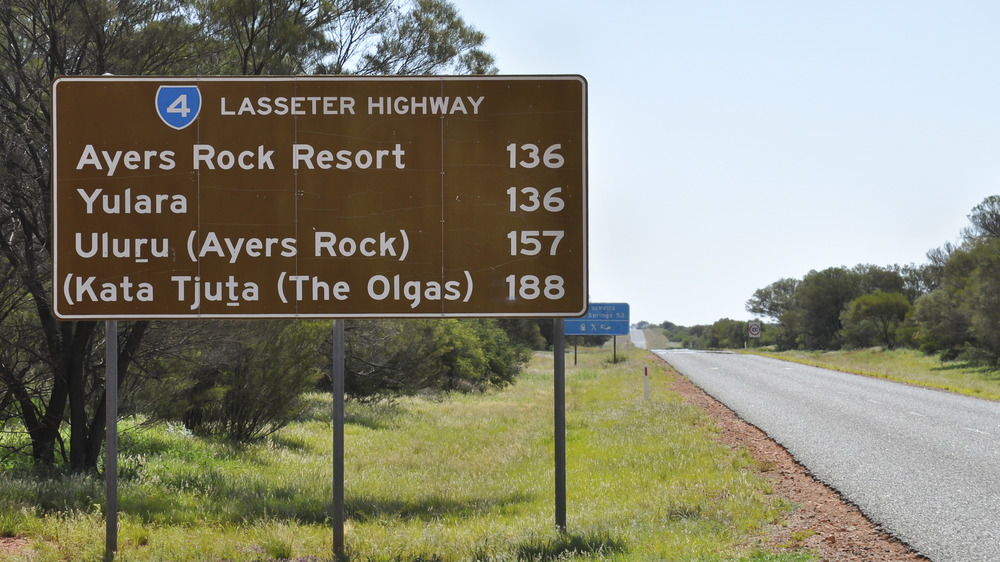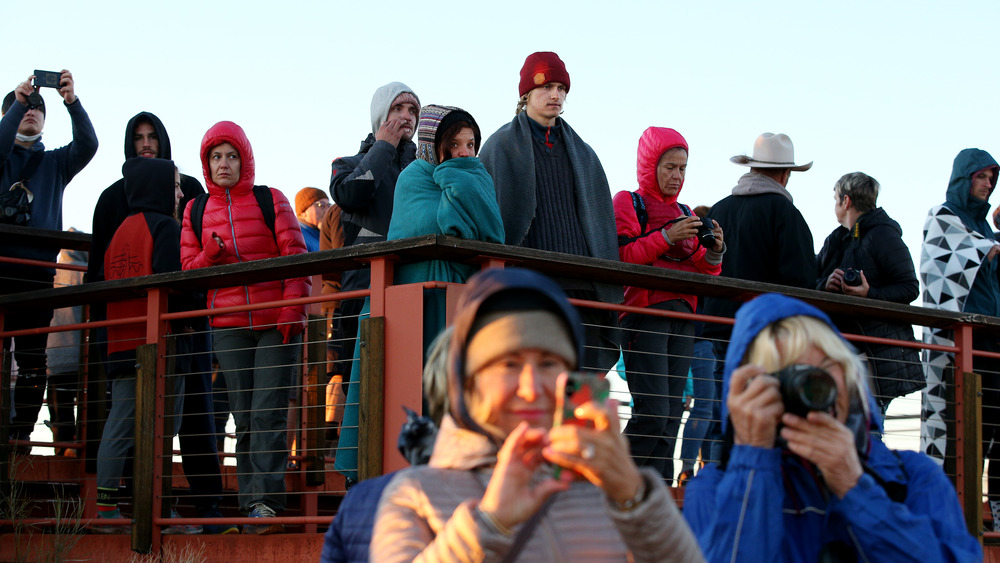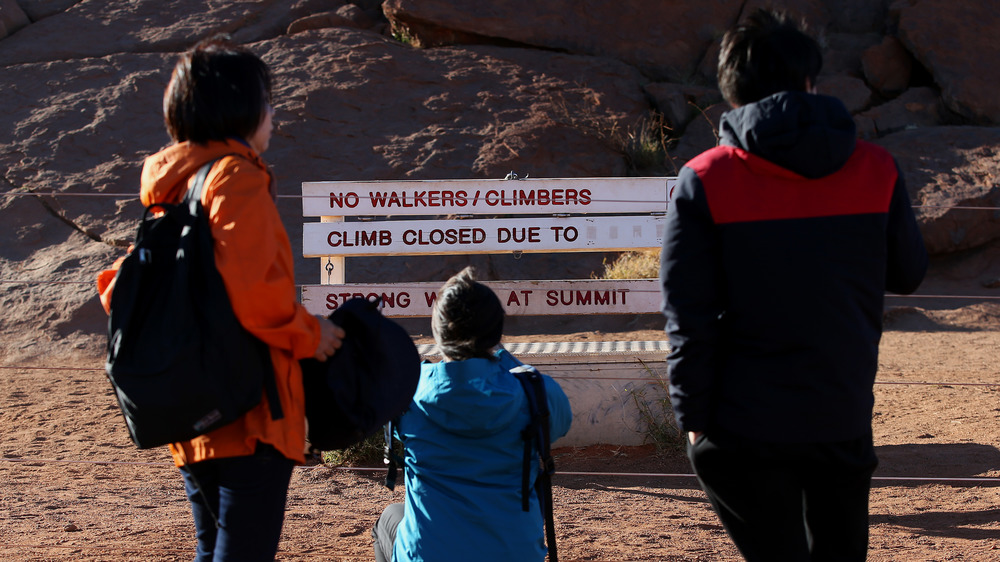The Tragic History Of Australia's Ayers Rock
Nestled in Australia's Northern Territory, right around the center of the continent, lies Ayers Rock, a towering monolith of red sandstone standing tall in the midst of a desert. It's an imposing and impressive sight, one which really does go to show the power and beauty of nature.
However, the rock formation is a lot more than a natural marvel. Ayers Rock has a pretty long history, and for much of that time, it was known solely as a monument of spiritual importance. But that wasn't meant to last. Parts of Ayers Rock's history — the relatively recent parts, especially — are tied up with injustices which, sadly, are common to not only other parts of Australia but other parts of the world.
Really, it's another example of what happens when European imperialism meets local, indigenous populations. In a lot of other cases, that sort of situation goes remarkably badly. In the case of Ayers Rock, it led to long-standing problems that went unsolved and largely ignored for decades.
Ayers Rock holds spiritual significance for the Aboriginal people
Ayers Rock — or Uluru, the name given to it by Aboriginal people — and its surrounding area were settled long before British and European explorers ever set foot on the land. And not by a small margin. More like 30,000 years, according to Uluru-Kata Tjuta National Park.
Knowing that, it's not really a surprise that the local Aboriginal people, the Anangu, have a deeply spiritual connection to the land. According to them and explained by Sacred Land Film Project, the land was once flat and completely featureless. No mountains, rivers, wells, or anything else. At the same time, their ancestors — ancient heroes — walked the land, and their exploits literally shaped the land around them. Those adventures would carve out caves, build mountains, and create every natural feature across the landscape, and the heroes would leave a part of their spirits behind in the process. The land ended up spotted with especially sacred sites, all connected by paths called iwara, which the ancestors of the Anangu had taken in times long since passed.
So the land wasn't just literal earth. It was a direct connection to a sacred and spiritual past, and when the Anangu walked the iwara in the present, they were actually walking alongside all those who came before them. It's a really deep connection to the land and to history on the whole.
The spiritual importance of the land governs daily life for Aboriginal people
The stories of the formation of the lands around Uluru are a lot more than some vague mythos for a few people to discuss every now and then. Instead, those stories pretty much govern the lifestyles of the Anangu.
The creation period — when heroes walked the earth and shaped the land — is called Tjukurpa, and it acts as the basic foundations for every aspect of the lifestyles of the Anangu (via Uluru-Kata Tjuta National Park). It outlines ideal familial relations, with those obligations to family extending past blood relatives, including anyone of the same language group. There are moral and ethical guidelines that Aboriginal people of any age can take from the stories, which also provide guidance when it comes to enforcing rules and laws. On top of that, it designates the Anangu as the protectors of the land (via Sacred Land Film Project).
And, naturally, a big part of any culture is how it's passed down. Tjukurpa isn't written down anywhere. It's remembered mostly through verbal stories, songs, dances, or various objects and art. Particular people are in charge of remembering certain chapters of Tjukurpa or sections of iwara, having been born into the position or else proved themselves worthy of it. The knowledge is passed down through ceremonies making use of sacred objects. After all, the Aboriginal people have every reason to keep their most sacred knowledge a secret.
Eventually, European influence made itself known
As is the case in a lot of countries around the globe, European — in this case, British — exploration and imperialism eventually made its way to Australia. It really started in 1862, with John McDouall Stuart crossing the entirety of Australia from south to north, paving the way for later infrastructure, though Uluru itself wasn't spotted until 1872 (via Uluru-Kata Tjuta National Park). That was done by Ernest Giles, who also named the nearby peak — called Kata Tjuta by the Anangu — calling it Mount Olga. He planned to be the first to make it to Uluru, only for William Gosse to beat him to it in 1873. Gosse was the one to coin the name Ayers Rock, naming it after the chief secretary of South Australia, Henry Ayers (via Uluru-Kata Tjuta National Park).
After that initial exploration, that same area started to look ripe for some scientific expeditions as well. Namely, 1894 brought with it the Horn Expedition. Financed by WA Horn, the trip was essentially meant to catalogue various aspects and natural resources of the land, like minerals, plants, and animals. What ultimately came out of this? The fact that this particular area wasn't well suited to agricultural endeavors.
So with European settlers deeming the land useless, it was set aside in 1920 as part of the Southwestern Reserve. And with the land being left to the Anangu, there wasn't much more European interference for the time being.
Tourism became a big industry around Ayers Rock
Maybe it's not really a surprise, but Ayers Rock didn't stay untouched by non-Aboriginal influence and ambitions. Heavy interference started with the apparent discovery of gold mines in the area around Uluru, according to Uluru-Kata Tjuta National Park, which suddenly increased interest in the area for the obvious reasons. The promise of gold ended up leading to the introduction of more infrastructure in the form of roads travelled by the mining teams, which also caused the shrinking of the Aboriginal reserve.
But the strange thing is that mining isn't really the industry that took over Ayers Rock and the surrounding area. It's actually tourism.
The existence of more roads and buildings allowed non-Aboriginal settlers to begin considering opening the land to tourism. By the mid-1950s, Len Tuit started capitalizing on that possibility, offering regular tours from Alice Springs to Ayers Rock for 20 people at a time, ultimately drilling wells on that route to provide fresh water for the tourists. And around the same time, the Cotteril family spearheaded the creation of more roads into the general area (great for the tourism industry), while also offering the first fly-in tours, partnering with Connellan Airways. Basically, tourism took hold in no time.
The effect of increased tourism wasn't exactly positive
Ayers Rock got named as a National Park in 1950, with Mount Olga later joining it, forming Ayers Rock-Mount Olga National Park in 1958 (via Uluru-Kata Tjuta National Park). Shops and motels popped up around the park, turning it into a real tourist stop (via Sacred Land Film Project). And that was great for the non-Aboriginal people and the tourism industry at large.
The thing is, that couldn't really be said for the Anangu who'd originally called that area home. In the space of a few decades, they'd basically lost control of lands that had been theirs for thousands of years. Tourists didn't know of their culture and beliefs, exploring and camping without a care for where they were, unaware that they were trampling ceremonial sites or places of sacred importance.
And the Aboriginal people didn't really have a way to stop it, because the tourism industry just didn't want them there anyway. Technically, they were still allowed to — and did — live on the land and hunt, though they were discouraged from being around popular sites while tourists were around. But over time, the tourism industry got more pushy about their own interests. In the mid-1960s, some legal circumstances meant that more Aboriginal people had moved to live near Ayers Rock, but pressure from the tourism industry had the government form a separate settlement at Docker River. After all, more settlement at Ayers Rock would just hurt tourism, right?
Aboriginal land rights have been a problem in places aside from Ayers Rock, too
The Aboriginal people around Ayers Rock saw their lands taken away from them due to the growing pressures of tourism, but the general problem of Aboriginal land rights has reared its ugly head elsewhere. Honestly, Aboriginal people saw Europeans as infringing and trespassing on their lands for some 200 years, as told by the National Museum Australia.
It's no surprise that this led to resistance. In 1963, the government wanted to open up a bauxite mine on the land of the Yolngu people. The Indigenous tribe sent a petition to the House of Representatives and launched litigation, but it didn't end up working. The mine went in anyway. Even a 1971 court case — the Milirrpum v. Nabalco Pty Ltd land case — didn't return their lands to them due to the Aboriginal definition of "property" differing from the European definition.
But this court case did recognize Aboriginal relationships to the land, breeding the modern land rights movement (via AIATSIS). In 1966, people of the Gurindji tribe went on strike against unfair wages, though it ultimately became a question of land rights. They broke non-Aboriginal law to camp on their lands and eventually saw part of their lands returned to them.
The 1970s saw a shift in the government's views
Luckily, the entire story of Aboriginal land rights isn't entirely doom and gloom. There are some bright spots. In 1972, the issue was actually put onto the government's agenda, with the newly elected Labor Party insisting that, while this problem persisted, all of Australia was really losing out (via Central Land Council). And so they decided to use the Commonwealth-controlled Northern Territory as an example of how Aboriginal land rights could be handled (rather than enacting federal, country-wide legislation).
Justice Woodward was given the task of finding a solution to these issues, and in 1974, the Aboriginal Land Rights Commission (or, Woodward Commission) released their final report on the matter (via National Museum Australia). In it, the commission stressed the idea of seeing justice served, compensating Aboriginal people for the land taken from them and recognizing the spiritual importance those lands held. The lands shouldn't be taken non-consensually for industries like mining, and the official response to these longstanding complaints would both promote stability across Australia on the whole, while also improving their image on the world stage.
The 1976 Aboriginal Land Rights Act and the Central Land Council
An increased federal interest in Aboriginal land rights did end up having a number of positive effects, and it seemed like things were looking up on this front. An important result of that interest was the 1976 Aboriginal Land Rights Act. The first of its kind, the Land Rights Act created four different councils to handle the issues of land rights in various parts of Australia, explains National Museum Australia. The government would purchase the land from private owners, then those crown-owned lands could be reclaimed by Aboriginal groups, so long as they could prove traditional ownership to those councils (via AIATSIS). In all, over 50% of the crown-owned land in the Northern Territory has been returned to Aboriginal hands, with other local governments following suit, albeit sometimes with certain restrictions.
And another big result of the new legislation was the creation of the Central Land Council. Basically, the group exists to protect Aboriginal rights and interests. They help Aboriginal groups reclaim their lands and make them prosperous, while also acting as a go-between for those groups and external interests who want to make use of the land. It's their job to consult with the Aboriginal people and ensure that their opinions are heard, making sure that their lands can't be used without their permission.
New legislation didn't fix all the problems
Sadly, the progress of the 1970s wasn't the end of all the problems. By the early 1980s, there were already attempts to weaken the 1976 Land Rights Act, due to mining companies and prospectors wanting back on the land, according to Cultural Survival. Fifty-five companies were granted licenses to explore, despite the Central Land Council appealing to the prime minister and citing the 1976 act, reminding the government of the tie between Aboriginal people and their land. But the Northern Territory government dismissed the argument as too emotional.
Around the same time, the Mabo Case finally convinced the court that Aboriginal people had a spiritual connection to their land and thus had traditional ownership (via AIATSIS). That led to the 1993 Native Title Act, which protected traditional ownership and applied to the entire country, rather than only the Northern Territory.
But even with that, there were still problems. The system made by the Native Title Act allowed for the claiming of traditional ownership, but the process was tedious, requiring proof of continuous Aboriginal governing as well as the creation of a separate corporation to deal with external interests. And on top of that, mining companies still protested the Native Title Act anyway, seeing it as giving Aboriginal people too much power (via Cultural Survival). They assumed that Aboriginal groups would veto any and all proposals to mine on their land, despite not really having any grounds to support that argument.
The legislation of the 1970s wasn't actually able to return Ayers Rock to Aboriginal owners
It would seem like the 1976 Land Rights Act and the general attention given to Aboriginal land issues in the Northern Territory should mean that Ayers Rock would've been immediately returned to Aboriginal hands, but that wasn't really what happened.
Ayers Rock was actually a special case. The 1976 Land Act allowed Aboriginal people to reclaim crown-controlled lands, but Ayers Rock wasn't crown-controlled. It'd been made into a national park, which disqualified it from being eligible for the Anangu to own, despite claims from the Central Land Council that the 1976 Land Act had been breached (via Sacred Land Film Project and Uluru-Kata Tjuta National Park). That claim did ultimately recognize 140 traditional owners for Ayers Rock, as well as 57 owners for Mount Olga, and it did allow for the return of the lands outside the park (via Uluru-Kata Tjuta National Park). The only problem was the park itself.
Still, in 1983 Prime Minister Bob Hawke did agree to return the lands to the Anangu, though it did take a couple more years for the transition to become official. The papers weren't signed until a "handback ceremony" in 1985.
Shortly after, the Anangu agreed to continue jointly managing the park — renamed to Uluru-Kata Tjuta National Park — with Parks Australia, and the park itself was named twice as an UNESCO World Heritage Site.
Despite Ayers Rock returning to Aboriginal owners, the problems haven't ended
The Anangu finally seeing the return of their lands wasn't quite the storybook happy ending that it feels like it should've been, because problems still continued well into the 2000s. After all, Uluru is still a major tourist destination, and that's basically the main issue.
Sacred Land Film Project explains that the park is busy and bordering on overcrowded. Four hundred thousand visitors every year isn't a small number by any means, and with that many people, it's hard to imagine sacred places feeling very sacred anymore. The spiritual part of the land seems like it gets lost, though, at the very least, photography isn't allowed in certain areas, maintaining the secrecy of ceremonial sites.
Plus, the natural ecosystem is something to think about. That much foot traffic ends up naturally trekking in non-native species to the area, which can potentially upset the delicate balance of the local wildlife. It's something that's been seen in other places before and to devastating effect.
And on top of that, the Anangu don't even benefit much from the tourism. Yes, they do make up most of the board and are employed by the park in a number of different positions, but the profits they see are pretty minimal. They aren't involved in the infrastructure that exists outside the park itself, and so they don't see profits from things like nearby hotels, which are built without their explicit say.
Climbing Ayers Rock is a particular problem
Tourism has been causing its fair share of problems at Uluru for decades, but one of the major consequences pointed out by Sacred Land Film Project is actually climbing. Tourists see the massive sandstone structure and simply want to reach the top, and that's the issue. Climbing Uluru is a complicated matter and for a couple of reasons
The Anangu themselves don't climb to the top of Uluru due to their beliefs, and they've discouraged people from doing so, implementing a system to educate tourists about the sacred nature of Uluru, hoping that they would respect it. Besides that, it's actually just not entirely safe, with people dying during the climb in the wrong weather conditions. To try and curb that, Uluru is closed off after 8 a.m. during the summers, and viewing platforms and paths were added in 2009 as an alternative.
But people would still climb it anyway, with nothing in place to enforce rules against climbing. Even when the board wanted to propose a full ban on climbing, the tourism industry just lost it. That said, there was an eventual agreement — climbing could be prohibited if certain conditions were met, such as less than 20% of tourists climbing Uluru when they visit. And that requirement was actually met, but not before further ones were added, with the climb remaining open until October 2019 (via BBC).
